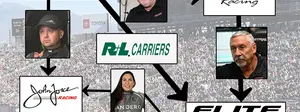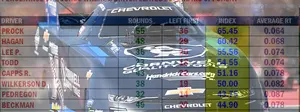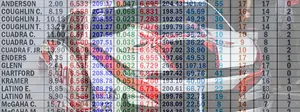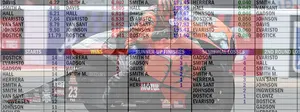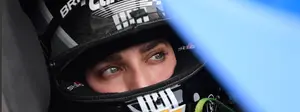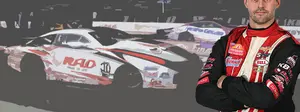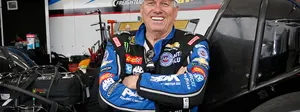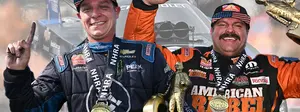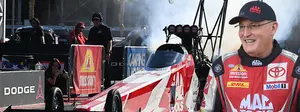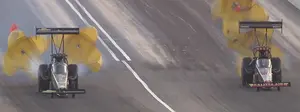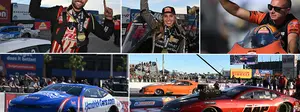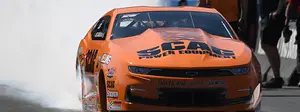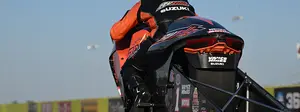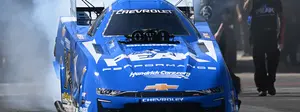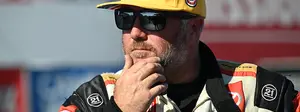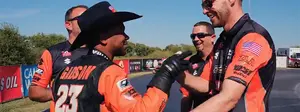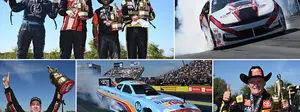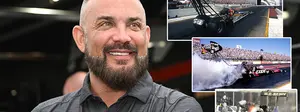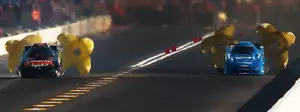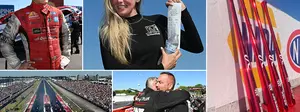

Super Stock icon: Inside the winningest car in NHRA [and Chevrolet] history!

Dan Fletcher is one of only three people in the history of drag racing to attain more than 100 NHRA wins, putting him ahead of many of the sport’s legends and in an exclusive club with John Force and Frank Manzo. He’s also the only person that’s swept the Western Swing twice.
From his first Super Stock win at Columbus in 1994, to his Super Stock runner-up at the 2020 Denso Spark Plugs NHRA U.S. Nationals, the car that has given Fletcher much of his success has been this iconic 1969 Chevy Z/28 Camaro. It’s the winningest car in NHRA history and the winningest Chevrolet in all of motorsports. No other Bowtie has won more races in any form of racing. Period. What’s so special about this car that has earned so many victories in such a competitive field? Is it the man? The machine? Or is there really no separation of the two?
Super Stock Secrets
In many cases, the key to success is beginning before everyone else, and this Z/28’s racing pedigree goes back to Day One. The Camaro was born as a legit crossram-intake, 302-cid, V-8, four-speed car. The kind of machine that was built to race, and the kind of car the collector market swoons over today.
“My father actually bought the car brand new, drove it home, and it’s been a racecar its entire life,” said Fletcher. The only miles it saw on the street were the ones it had to traverse coming home from the dealership. Every other mile has been clicked off on dragstrips around the country.
Fletcher’s dad ran the car in Modified Production in the 1970s, and then parked the car for a time. When Fletcher neared driving age, he says he dragged his dad back into racing and turned the Camaro into a bracket car in the 1980s and then reworked it to race Super Stock in the early 1990s. When asked about the secret to this car’s success, Fletcher says it’s a relentless mixture of “hard work and perseverance.” He says he gained his work ethic from his dad. “I think I’m a pretty hard worker, but my father would’ve put me to shame,” said Fletcher. “He was an extremely diligent and detail-oriented person.” The kind of person that inherently understood what he had to put in to get out what he needed to win.
It’s a bulldozer with a stack of good timeslips.
So what details matter to Fletcher and his Camaro? He focuses on the work – not the parts – that make the car quicker and its performance more predictable. It’s a bulldozer with a stack of good timeslips. We couldn’t help but notice lots of well-seasoned speed parts on the Camaro, and almost nothing we’d describe as “exotic.”
Fletcher told us, “I’m a creature of habit, and I try to keep everything simple.” He concedes he has a number of buddies that buy the best of the best stuff for their cars, but he’s not that guy. He’s been racing this car long enough that he’s figured out the quality components that work, but rarely has the highest-dollar version of anything on the car. “I’m not the trick-of-the-week guy. I’m not trendy. I’m just old-school function above a everything else,” he told us.
Between these shock towers Chevrolet installed its 302-cid crossram dual-quad race engine. Since then it’s been home to various small- and big-blocks and even an SB2 NASCAR engine. Now there’s a 350-cid COPO engine featuring an LS7 aluminum block, LS3 heads, and a Holley Hi Ram intake that barely fits under the cowl induction hood after a pair of spacers were added to create an optimal flow path. There are more zip ties and butt connectors than we expected in this car, but as Fletcher reminded us, “My sh*t always starts.”
You can practically see flakes of dried blood in the AN lines that Fletcher made for this car. He reports that he only had to change one line to switch from the carbureted small-block he had to this LS engine. Fletcher also recounted the school-of-hard-knocks lessons he learned about fuel pressure. It wasn’t until he swapped the car to a -8 AN feed and a -10 AN sized return that the regulator was able to control the fuel pressure. By our count, at least three different mounting patterns for the fuel pressure regulators that have been tried over the years on that original wheelwell.
We’ll save you the trouble of asking: The odometer reads just 653 miles. That’s not the real number though. Fletcher told us the cable hasn’t been hooked up in decades and that the numbers have vibrated up to that mileage reading. The instrument panel, carpets, and pedal assemblies are all well-worn from races around the country. This is Fletcher’s home office after all.
There was a period of time the car ran with a 396 big-block and a three-speed automatic in the early 2000s, but other than that, this Hurst has been in the car for nearly 30 years. An electric shifter from Biondo Racing has been handling the 1-2 gear change nearly as long. Currently there’s a two-speed ATI Powerglide under the tunnel, but Fletcher thinks the car needs a three-speed to take advantage of the engine’s powerband.
The transbake control also looks like a vintage speed part, and was in the car way back when Fletcher began racing. When he accidentally fell off his motorhome in 2003 and “broke the whole right side of my body,” says Fletcher, he had to come up with a way to leave the line using just his left hand. So there’s a button on the steering wheel in addition to this one on the floor. “Sometimes I’ll go with that button, sometimes it’s the other one.”
The sheetmetal on the car is all original, and Fletcher’s father back-halfed the car for the first time in the early ’80s. Dan remembers seeing the car supported on a picnic table as the jig. The car has since been redone by Gary Wisecarver of Rustburg, Va. The Mickey Thompson tires have been a staple product for this program for the last 25 years, but the Weld Wheels were new for 2019. Fletcher says, “I always wanted them, but couldn’t always afford them.” When asked about the 7075 aluminum lug nuts that hold the V- Series double beadlocks on, he conceded those were his kids’ idea, but so far he’s been happy with them.
A pair of Optima Yellow Top batteries flank the Aeromotive-pump equipped fuel cell and a homemade weight box that allows Fletcher to work with the ballast in the car. When asked if there are any bolts that have never been removed from the car he said that the rear bumper bolts only come off to pain the car – which happened in 2019.
The 33.0/14.5R15 M/T Pro Drag Radials are stuck to the ground with a 40-spline Ford 9-inch spinning 5.38 gears from Strange fitted with a steel spool for durability. The Penske coilover shocks are from back when that company paid NHRA Contingency sponsorship in Super Stock.
40 Years of Testing Parts
It becomes apparent after looking over the car that’s it’s a metaphor of the driver – they’re both practical to a fault and ego and showmanship are afterthoughts. Their inspiration will cause you to reconsider the next part you add to your racecar, if not very well remove something that you’ve recently been distracted by. Case in point, check out the fuel system. There’s a state-of the-art brushless in-tank pump in the fuel cell, but you’d never know it. It’s the hand-made braided lines zip-tied in place that catch your eye. No Teflon-lined hoses or O-ringed clamshell connectors here. Just traditional red and blue AN fittings that were proven in aircraft before this car even rolled off the assembly line. There’s nothing primitive about the design, however, as the lines have been built to reduce the number of fittings and sized to feed the engine and allow the regulator to control the fuel pressure correctly. “All of the fuel lines you see under the hood were repurposed parts I had in the basement,” said Fletcher. “I have nothing against the newer black fuel line but if I have parts on hand and there are holes already in the car (from other combinations the car has run) I use what I have.”
Another recurring theme with Fletcher is his refrain of “I’m not a wealthy man.” What he’s really means when he says that is he’s “not a wasteful man.” If he can accomplish his goal with what he already has, he will. Whether that’s working out of his 20-year old trailer, driving his 17-year old motorhome, or chasing parts in the 1-ton pickup he was driving back from his engine builder the day we spoke to him.
This man and machine have succeeded by knowing how to use what they have to the fullest. There’s no magic bullets here. He understands how to get the parts he has to respond. “Too many people get lost when they start changing stuff,” he says, “and it’s hard to find your way back sometimes. Even for me.” He claims that most of the time he tries to do something new, or make something better, it ends up setting him back. So the pace of evolution for the car is intentionally slow and methodical.
Is the Car Still Competitive?
Champions learn from their mistakes as well as their successes, and Fletcher’s 2019 and 2020 NHRA seasons have been his longest run without a Wally. Was the new LS engine combination in the car the reason? Perhaps, but Fletcher isn’t quick to lay blame on any one aspect of his program. “This has certainly been the longest dry spot I’ve ever had,” said Fletcher. “Last year was the first time in 25 years that I hadn’t won a race.” He got close and he drove well, but as he tells it, “It wasn’t in the cards.”
His 2020 season never allowed him to get into his zone either. So he’s been working on the car’s intake and torque converter combination to run the numbers he needs. Keep in mind he’s working with the parts that he started 2019 with, and he’s making minute refinements and avoiding new variables. “You’re never going to get really good at something if you just keep changing it,” says Fletcher. “Eventually you’ve got to dig in and just make one system work, and refine it. I’ve literally been driving the same car for 40 years.”
What allows him to have that kind of focus on the same machine all of these years? His father. This ’69 Z/28 isn’t just a Super Stock racecar. It’s his sibling. It’s his livelihood. It’s also his legacy. His relationship with it is an homage to his dad, and it’s been as constant as a brother in his life. “The 69 Camaro is one of the most iconic cars ever, but for me personally, I was an only child, and since the day dad drove that car home it’s been there virtually all my life,” he said. “To consider ever not having that car would be just, you know, forget it. I’ll never know life without this car.”
What, This Was Supposed to be a Hemi Dart?!?
Dan Fletcher’s dad wasn’t a Chevy guy, he was a Mopar guy. His racecar before this was a 440-powered ’67 Coronet R/T that ran in C/Stock Automatic. The ’69 Z/28 Camaro was his second choice when the order he placed for a ’68 Hemi Dart wasn’t going to get him the four-speed transmission he wanted. The order was canceled, and a friend at the local Chevy dealer hooked Dan’s dad up with this ponycar. So were we really that close to seeing Dan Fletcher in the Hemi Challenge? “I think about that all the time,” says Fletcher. “Those Hemi cars aren’t exactly go-rounds bracket cars.” Would Fletcher have swapped engine combos and followed the same game plan as with the this Super Stock Camaro? “Who knows,” says Fletcher. “Had my father bought that car, history might look significantly different.”























